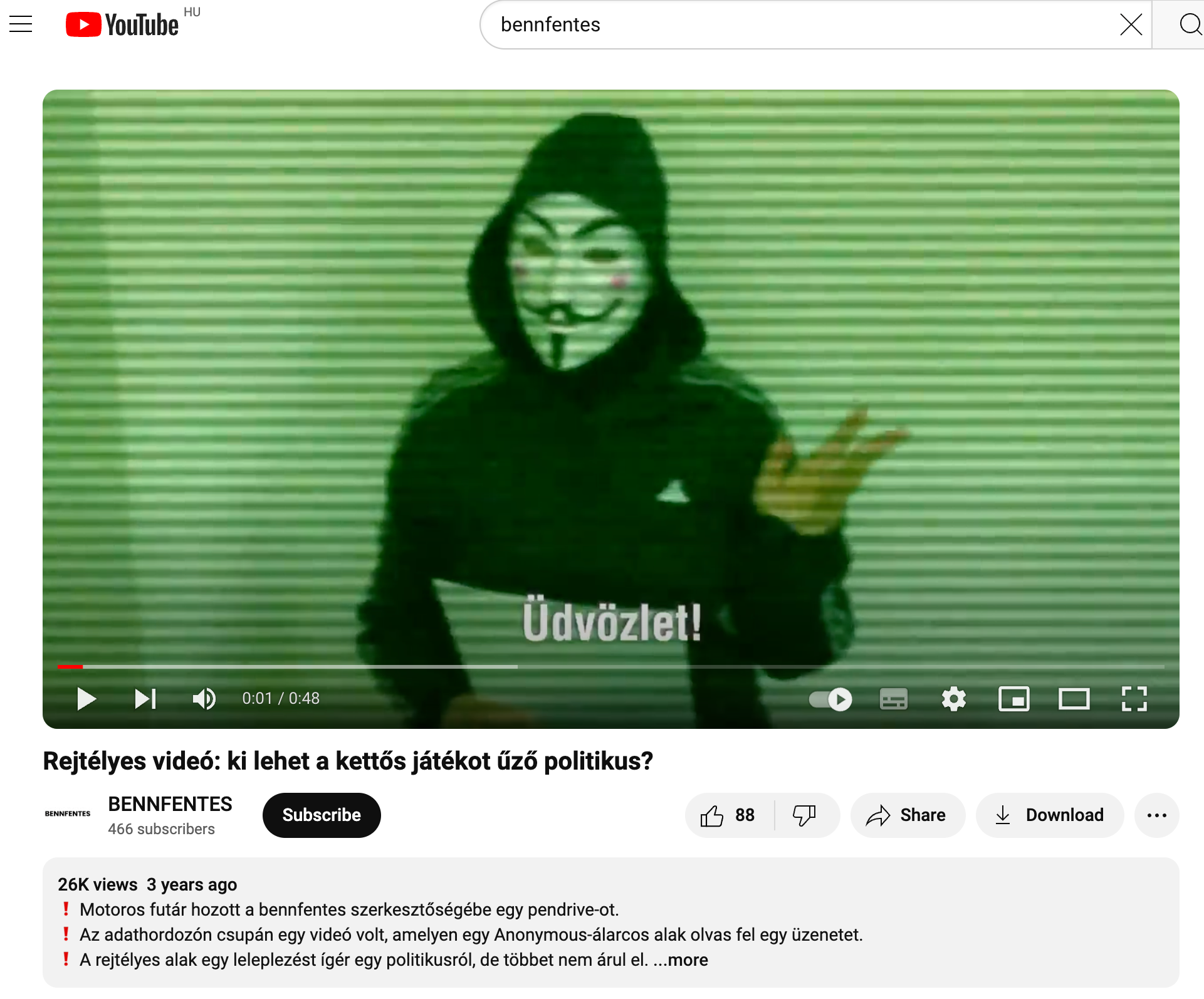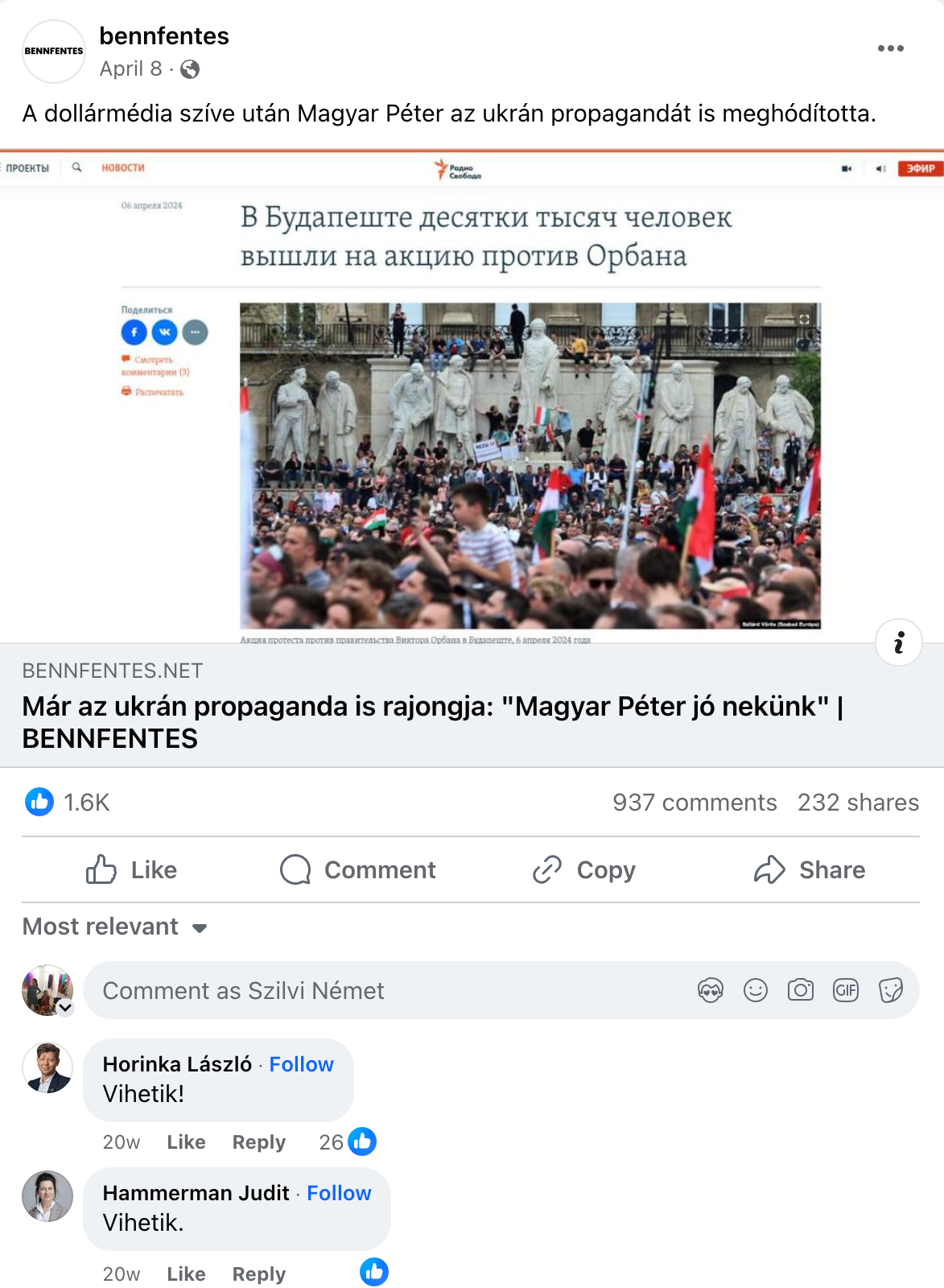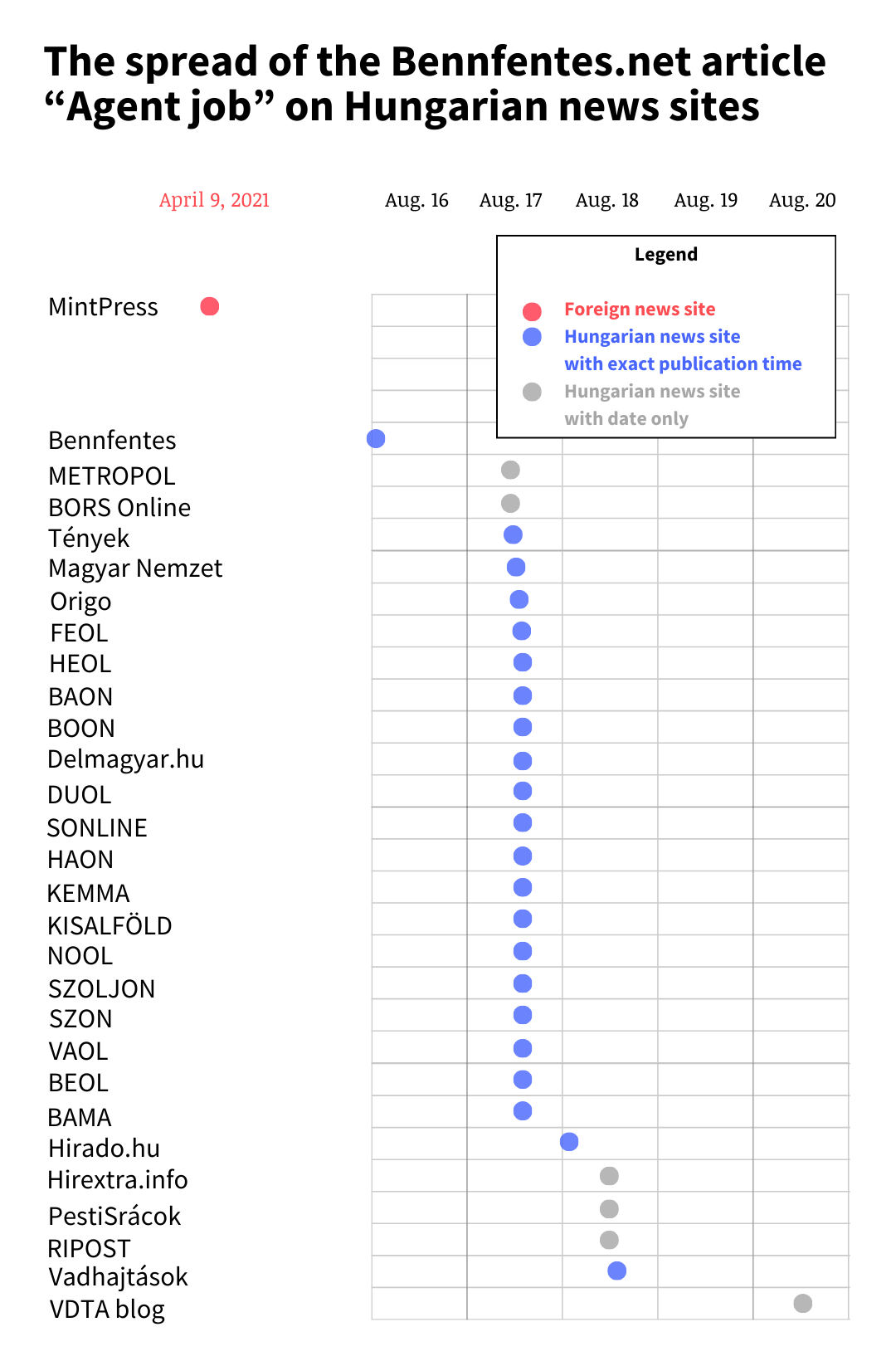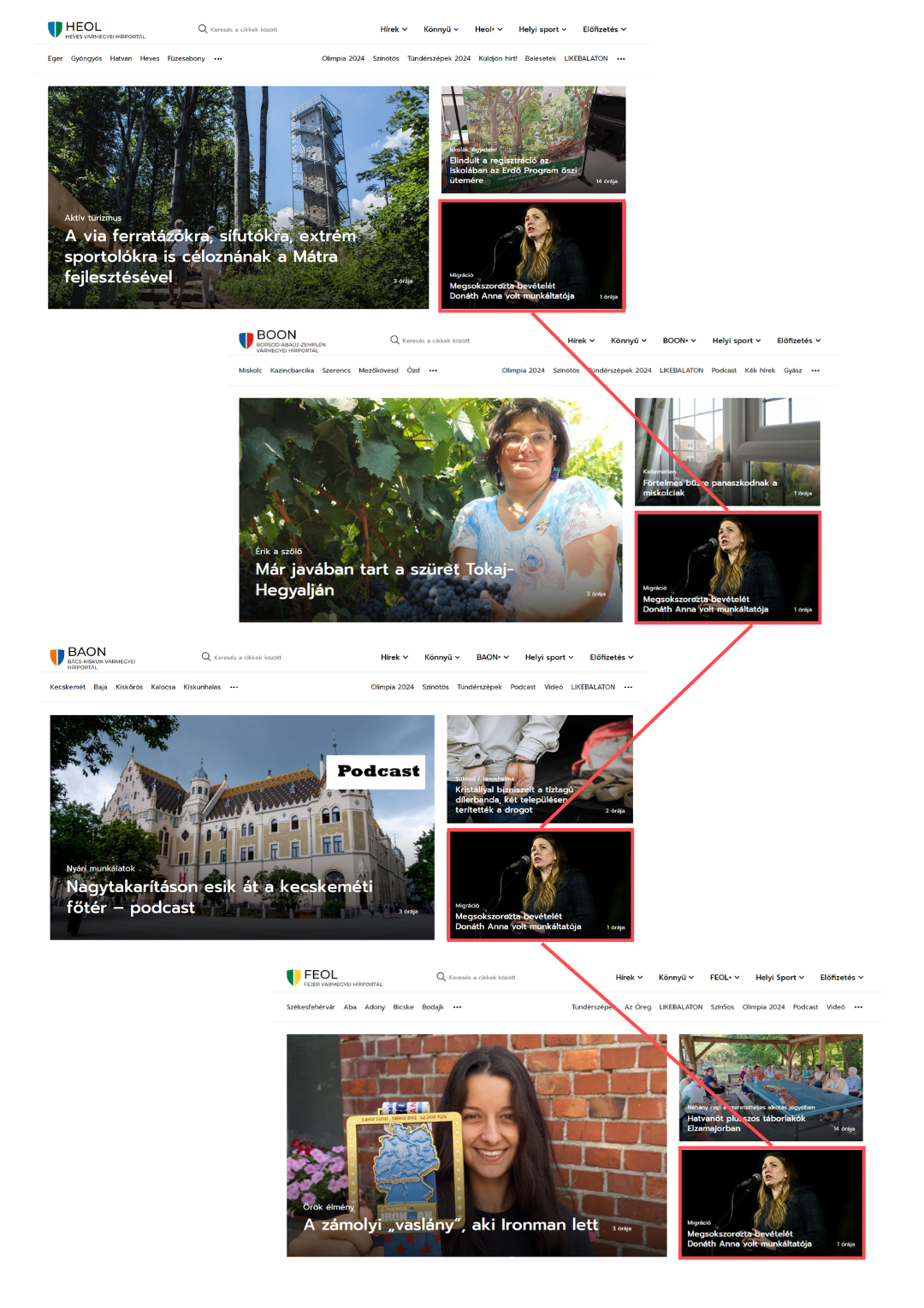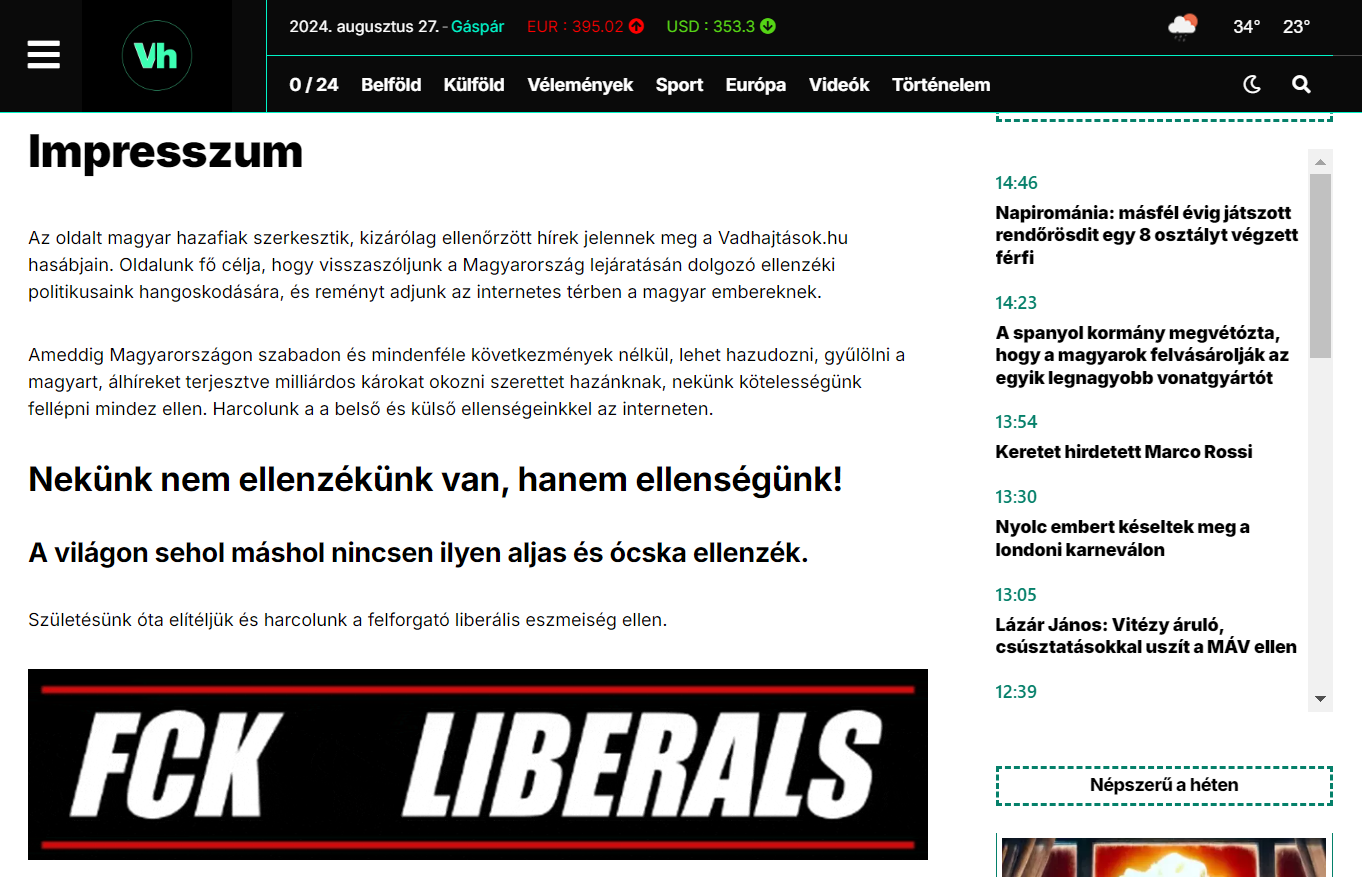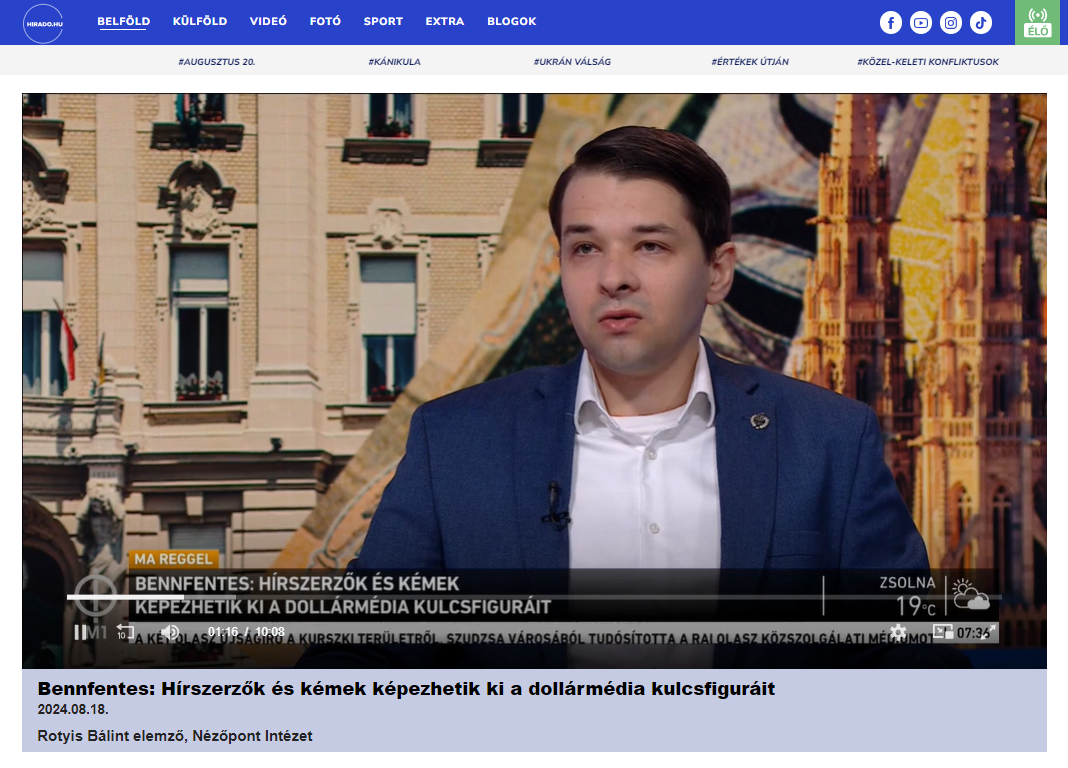Hungarian pro-gov media uses favorite source of Russian state media to discredit The Eastern Frontier Initiative
2024. szeptember 4. 00:00
Ezt a cikket 2024
szeptemberében írtuk.
A benne lévő
információk azóta elavulhattak.
Hungarian pro-government newspapers used a 2021 article from the pro-Russian American far-left news website, MintPress to accuse 444 and its international partners of information warfare.
On 16 August, the pro-government media launched an all-out attack against the consortium The Eastern Frontier Initiative (TEFI), a group of four Eastern European newsrooms (including 444), and the independent Dutch investigative collective, Bellingcat . The project focuses on security policy issues in Central and Eastern Europe and is co-funded by the European Commission. The smear campaign has taken the years-long stigmatization of independent news outlets to a new level. It now alleges not only that 444 is funded from abroad and therefore serves foreign interests, but also that it is in contact with foreign intelligence services through Bellingcat.
The scandal site, Bennfentes (meaning “insider”) initiated an attack against the consortium with an article , “Agent job: intelligence agents and spies are the cream of the dollar media” written by an anonymous author. In this context, “dollar media” refers to independent news outlets. Within days, the article’s main allegations swept across the pro-government media, from the so-called public media through the local newspapers published by Mediaworks to the tabloids.
A statement issued by 444 points out that the article published on Bennfentes could also help the work of the Sovereignty Protection Office as it uses concepts such as “information interference”, “pressure” or “manipulation of public opinion”, which the office also refers to in its procedures.
However, a closer examination of the defamatory article reveals that the allegation of intelligence links is based entirely on a three-year-old story published by the US-based alternative news portal MintPress News. MintPress is frequently quoted in Russian state media and by the Kremlin.
In this article, we summarise:
- how Bennfentes took over the US portal’s original material and what can be learned about lesser-known media outlets that are involved in smear campaigns,
- and which Hungarian news sites and Facebook pages were involved in the distribution of the material attacking the consortium.
Bennfentes: the “sleeper portal” calibrated for scandals
Bennfentes is not a new weapon in the pro-government communications machine. The web portal’s place in the public sphere was marked in the autumn of 2021 when the Budapest “City Hall case” broke out during the opposition primaries. The platform’s YouTube channel was used to publish defamatory materials about opposition politicians and Mayor Gergely Karácsony, which resembled leaks by the Anonymous hacker group and were created by unknown persons. The creators of the “City Hall case” used Russian disinformation methods: a case (the sale of the City Hall) was invented without any basis in facts and then kept on the agenda for half a year. However, no such case ever actually existed, the building is still owned by the municipality of the capital.
According to the video’s disclaimer, the information was brought to the editorial office by a motorbike courier. Source: YouTube
Since then, Bennfentes has been a reliable source of (fake) scandals targeting the government’s real or imaginary opponents: like the “ real estate shenanigans of Sándor Szaniszló”, mayor of a Budapest district and member of the DK (the “Democratic Coalition” party, then the strongest opposition party), Tímea Szabó’s “cocaine business” or Katalin Cseh’s network of companies that worked as a criminal organization .
However, the site is mostly idle, only occasionally coming to the spotlight for publishing articles with dubious backgrounds.
With only 1800 page views in June 2024, Insider does not even try to function as a traditional news outlet: the site has never been registered with the Hungarian Media Authority, it does not have editorial staff (since the beginning of 2023 it has had zero employees, according to OPTEN’s company database), and most of its articles are published without authors.
For most of the year, there’s not much to read on the Bennfentes website: this year the first article was uploaded in April, and since then only one or two pieces of writing per month (nine in total since the beginning of the year) and a few cartoons have been published. The fascination with drawings is no coincidence: the company’s managing owner and editor-in-chief is Károly Pósa, a Vojvodina artist, writer, and blogger.
On the Facebook page of Bennfentes, some of their featured content is liked or commented on by a disproportionate number of people compared to the number of followers. These articles are also typically promoted by the official profiles of government politicians, seemingly in a coordinated way.
For example, an article published on 8 April, the day before the municipal and European elections, “Even Ukrainian propaganda is already a fan: ‘Péter Magyar is good for us’” received a record 937 comments. Among the commenters were several Fidesz MPs and mayors, including some who took part in the workshops of the pro-government propaganda center, Megafon.
List of commentators: László Horinka, mayor of Sülysáp, Judit Hammerman, candidate for Erzsébetváros and many others. Source: Facebook
Another anonymous article
In its 16 August article attacking 444 and its international partners, Bennfentes largely deals with Bellingcat and its founder, Eliot Higgins. The anonymous author of the article accuses the international investigative portal, based in the Netherlands, of having “intelligence agents and spies working in journalistic cover”. The article then details the biographies of the portal’s contributors, with a particular emphasis on their alleged intelligence connections.
Although there is no acknowledgment of the source in the article, the “incriminating evidence” is taken in its entirety by Bennfentes from an April 2021 article in MintPress News, an alternative US portal.
The Hungarian scandal site translated a total of 15 paragraphs from the original text into Hungarian. Bennfentes refers to the source of the information as a “detailed investigation’, but does not mention the name of the portal.
But what is MintPress?
MintPress News, according to its Facebook page , is an independent press organization founded to expose “the detrimental effects of imperialism, corporatocracy & the fading away of our civil liberties.” The editorial office is headquartered in Washington, D.C. (according to other sources , Minneapolis). At first, the online newspaper tried to survive on reader support, but later its funding became opaque , and even its staff do not know how it is financed.
The online news site was founded in 2012 by journalist Mnar Muhawesh Adley, whose LinkedIn’s profile describes her as “the first American anchor to wear a hijab”. According to former employees interviewed by BuzzFeed, the news site is a family business: in addition to Muhawesh, who is of Jordanian descent, her brother-in-law and father-in-law also play a role in running the paper.
Mnar Muhawesh Adley, Founding CEO of MintPress News. Source: YouTube
The articles on the site are available in six languages: English, Russian, Spanish, Arabic, French and Chinese, thanks to its built-in translation software.
MintPress articles have recently focused almost exclusively on the Hamas-Israel war and the exposure of “Zionist propaganda” about it.
The other main goal of their articles is to expose the alleged role of US intelligence services in current or historical conflicts.
However, the treatment of the topic in their analyses is rather one-sided. To take just one recent example, in connection with the protests following the Venezuelan presidential election, the site reported that the opposition group questioning the election results had received a threatening message from the head of Blackwater, a US mercenary army involved in “CIA-linked assassinations”. However, it was not reported that soldiers wearing the insignia of the Russian-linked private army Wagner were documented to have been present among the security forces deployed by Maduro in the Venezuelan capital.
Because the paper regularly goes up against the US establishment, it is particularly popular in the Russian media, and we know of several cases where MintPress articles have been used exclusively to prove alleged US influence or interference.
RT: “The best independent online news source”
The international press first started to pay attention to MintPress due to the coverage of the Syrian civil war in 2013, shortly after the site was founded. The biggest backlash was caused by their article in which they claimed, based on unverified and confusing information, that the chemical attack on the outskirts of Damascus that killed 355 civilians was carried out not by Syrian President Bashar al-Assad but by rebels armed by the Saudi government. The Russian Foreign Minister Sergei Lavrov and the Syrian and Iranian state-controlled media immediately picked up the flimsy story. MintPress was then first involved in a conflict with Eliot Higgins whose investigative career was also founded by this incident .
The Russian state news channel RT (formerly Russia Today) has referred to the MintPress news portal a total of twenty-five times since 2014, and several of their reports have been based exclusively on the alternative portal’s “factual findings”. For example, citing MintPress articles as evidence, they claimed that
- there are personnel links between TikTok and NATO and US government agencies,
- Twitter has an alarming number of former spies with a secret service background,
- Bill Gates’s foundation is influencing the newsroom of The Guardian through grants, or that
- Microsoft’s election software rigged the 2020 US presidential election.
In this article , in which an interview with the founder-owner of MintPress was re-published by RT,
the Russian channel called the paper “the best independent online news source”.
MintPress regularly broadcasts pro-Kremlin narratives on Russian-related issues. In 2019, for example, foreign affairs spokeswoman Maria Zakharova was interviewed in Moscow before visiting the Russian-annexed Crimea and the two self-declared “republics” of Donbas, Donetsk and Luhansk People’s Republics. In their on-site reporting , MintPress News then referred to the 2014 events as a “coup d’état”, the annexation of Crimea as a “return to Russia” and the referendums as “a free choice for the people”. (The results of the referendums have not been recognised by most countries in the world since then, because they were held in contravention of the Ukrainian constitution and did not comply with international legal standards .)
In their articles on Ukraine, the authors of the portal have since written about “ mistaken US strategies ”, “ Donbas genocide ” and “a conflict provoked by the West”.
Timed wildfire in the pro-government press
The article attacking 444, based on a 2021 piece by MintPress News, swept across the entire Hungarian pro-government media in a matter of days. The article, which was copied verbatim, was presented by the newspapers and news sites as an original investigative material by Bennfentes. The artificially increased importance of the news is shown by the fact that tabloids led by pro-government actors also published it, and at the weekend edition of a programme on the public service television, which is in fact a pro-government propaganda channel, they analysed the case in a 10 minutes with the help of pro-government experts. The pace, coordination and platforms of sharing the information suggest coordinated behaviour, confirmed by the fact that newspapers have the same publishers and owners.
The day after Bennfentes published the article, 24 news sites shared the “investigative piece” verbatim, 21 of them owned by the pro-government MediaWorks Hungary Zrt . Among them are sites with national coverage, such as Origo, Magyar Nemzet and Pesti Srácok, but the county newspaper network acquired by the media company has also become active: at exactly the same time (13:54 on 17 August), sixteen county news sites shared an article on the case with the same title and text (only two daily newspapers have not published an article on the subject).
The spread of the Bennfentes.net article “Agent job” on Hungarian news sites.
The Hungarian government has been working on the centralisation of media since 2010, and the coordination of county newspapers has become a familiar phenomenon since the newspaper publisher MediaWorks Hungary Zrt. was taken over by the Central European Press and Media Foundation (KESMA), thus completely subordinating local newspapers to government mass media. Following the change in ownership, editors-in-chief and publishing managers were dismissed , and then the websites had unified design and similar name (a 4-letter abbreviation of the county name). Government pressure has led several journalists to leave voluntarily , and the tighter control of content is also noticeable, one of the most obvious signs of which is that the same news, apparently written in a central editorial, is now published in all the local papers.
KESMA became Hungary’s largest pro-government media empire in 2018, when pro-government businessmen (such as Árpád Habony, Ádám Matolcsy and Mária Schmidt) simply handed over 476 media outlets and products on the same day to the conglomerate. The unconcealed aim of this powerful media holding is to convey the position of the governing party, and to this end the second Orbán government in 2018 declared the acquisition of several media outlets by KESMA as a matter of “national strategic importance” by means of a government decree .
Pro-government actors can also be identified among the owners of the media outlets independent of KESMA and MediaWorks that shared the article published by Bennfentes. The online portal “Tények” (Facts) is published by TV2 Média Group Zrt., a company linked to Orban’s friend, the oligarch Lőrincz Mészáros, which receives regular state funding and whose staff openly supported Viktor Orbán during the parliamentary election campaigns.
Those who reacted later
Following the coordinated response of the pro-government media, Vadhajtások (Wilding) and the blog of the Védett Társadalom Alapítvány (VTA), meaning Protected Society Foundation also ran the article accusing 444 of collaboration with the secret services. Vadhajtások has been run anonymously for 6 years now, without imprint or authorship, publishing extreme right-wing and radical nationalist contents. Several criminal proceedings were launched against the operators for their hateful and anti-Semitic statements, but the police suspended the investigation for lack of criminal offence or because it proved inconclusive. The case initiated by 444 , which has been ongoing for five years, was closed this year on the grounds that “it is not possible to obtain information about the person(s) who uploaded the content to the site”. The reasoning is surprising given that Zsolt Bede, who is notorious for his extreme right-wing views, has openly admitted to managing the site since 2018 and is repeatedly referred to in interviews as the site’s publicist or spokesperson. Despite the inflammatory articles and prosecutions, the content of Vadhajtások is regularly reviewed by pro-government media, referring to Bede simply as a right-wing correspondent.
The “masthead” of Vadhajtások.
The VTA was set up as an opposition to the George Soros’s Open Society Foundation. Their aim is to “defend normality”, and among their representatives are pro-government figures such as László Földi, a popular security policy expert in the right-wing press. Kristóf Trombitás, one of the most influential pro-government propagandists was also a founding member of VTA. It seems that Trombitás has since left the organisation to focus on Fidesz’s so-called “influencer training center”, Megafon.
International support = intelligence influence
In addition to the pro-government media, public service television also covered the case shortly after the publication of the original article. M1 summarised the article in its morning programme , and then a reporter from the public channel spoke to Bálint Rotyis about the background of the case. The analyst from the pro-government Nézőpont Institute treated the content of the Bennfentes article as fact, adding only an overview of the Hungarian media system to the questions addressed to him. “These institutions do not work exclusively from their own resources, but in return, they receive foreign funding and foreign training”, he said, summarising the role of the independent media, adding that Western European secret services are also trying to gain influence in Hungary by exploiting the infrastructure built by George Soros. Rotyis said that this was the reason why the independent media, which he also described as pro-war, always defined the Hungarian government’s pro-peace messages as pro-Russian. 444’s alleged pro-war stance is in line with this year’s report by the Sovereignty Protection Office. The Office has identified two “disinformation narratives” in Hungarian public discourse on the Russian-Ukrainian war: the Russian state narrative and the Western pro-war narrative. They claim that the latter tends to appear in independent Hungarian media outlets such as Telex, 444, 24, HVG, or Népszava.
Bálint Rotyis pro-government analyst in the Sunday morning (18.08.2024) programme of the public service channel, M1 repeated the accusations of the Bennfentes article.
In the live broadcast, Mr Rotyis linked foreign funding, journalists’ training, and the possibility of influence.
“In these trainings, journalists will probably be informed about what to cover, how to present certain issues, and in what narrative to frame them. So here, the inner circle of journalists has access to a lot of information that we may not even know now, and they also receive guidance on how to present that information in the future,” he commented.
Coordinated spreading of fake news on Facebook
Although the most popular pro-government pages on Facebook have not yet joined the new smear campaign against 444, we have identified signs of coordinated distribution on smaller Facebook pages and in public Facebook groups. The seemingly unrelated sites were not promoting the original Bennfentes article but shared a verbatim copy published on Hirextra.info.
Hirextra.info, a website mostly dedicated to the republishing of articles, published the article by Bennfentes on 18 August. Not much information can be found about the operators of the site, which is registered through a proxy company and has no imprint or social media access.
Despite this, the Hírextra article was shared in two waves, within seconds of each other, by right-wing Facebook pages with unidentified backgrounds, whose political and ideological affiliation can be deduced from their names (for example, the “Daily migrant, vaccination, politics” group with more than 3,000 members or the “I support Viktor Orbán, Putin and Trump” page with 848 followers ). The Jobboldali Médiahírek (meaning “Right-wing media news ”) page was first, then its post and the Hirextra.info article (as documented in the table below) were shared by five more FB pages or groups at 15:06, and then shared by ten different Facebook pages two minutes later.
This is not the first time that seemingly unconnected sites have acted in a coordinated way: as previously reported on Lakmusz , an extensive network of apparently coordinated sites regularly disseminates news supporting the government's narrative.
(Cover photo: Szilvi Német)
A szerzőkről

Barczikai Fanni
A Budapesti Corvinus Egyetemen végzett politológus, az ELTE-BTK mesterszakos hallgatója. Az Achilles Data nemzetközi oknyomozó újságíró program díjazottja és a Pelikán Projekt okleveles újságírója. A Lakmusz csapatához 2024 márciusában csatlakozott.

Német Szilvi
Újságíró, médiakutató. Az álhírek és a dezinformáció terjedését vizsgálja a közösségimédia-kutatás eszközeivel, valamint a technológiai platformok és a rejtőzködő médiaorgánumok szerepével foglalkozik.
Kövess minket
Ne maradj le egy anyagunkról sem, kövess minket máshol is!
